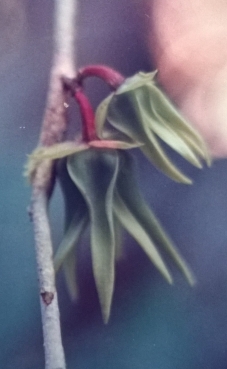Desmopsis schippii Standl.
Annonaceae
Rare evergreen treelet or shrub (2-4 m) preferring the wetter, even water-logged, soils of forested valleys, bottomlands and streamsides. Desmopsis is one of the rainforest’s true, dark-adapted plants, able to eke out a meager survival in the deep shade of the dense forest interior. The species is interesting for the complex, intricately detailed fruits and flowers it produces semi-annually.
Description: Often taking shrub-like form, Desmopsis grows with one, two or three main trunks, each measuring about 3 cm in diameter. Irregular, these stems give rise to a thin set of angular branches, sparsely covered with large (15 cm by 6 cm), broad, smooth leaves. Simple, alternate, and elliptical in shape, the blades sport short (1 cm) petioles and moderate drip-tips. Leaf veins are deeply impressed into the blade’s upper surface. New foliage is produced in September, with approximately 40% of the treelet’s cover renewed at this time.
Flower buds – really just green, miniature versions of the mature blossoms – become visible in the same month, emerging from leaf axils and along the leafless portions of the branches from old leaf scars. Each adult flower is composed of a vertically hanging collection of yellow, spike-like petals capped by a red, three-part calyx and pedestal. Measuring 5 cm in length, the six petals (each strongly curled about a longitudinal axis) are splayed outwards at the bottom of the blossom. Deep inside this complex corolla lie six short stamens that are attached to the top of a fat, central pistil. Blossoms emit a faint, banana-like odor. Flowering occurs from September through October with a secondary event often observed in January and February.
Fruits, resembling spiked balls (8 cm), begin to grow immediately, reaching maturity after about two months. Initially, they appear as a cluster of rice-sized grains attached to the end of the flower ovary. Later, these grains spread apart and enlarge into approximately twelve, yellow, club-shaped appendages that radiate outward from the swollen, red hub that serves as their common place of attachment. Each fleshy club contains about five, longitudinally stacked brown seeds. Disk shaped, the seeds (6 mm) are circumscribed by prominent, lateral grooves. Fruits mature in December and, to a lesser extent, in May.
Similar Species: Due to its small stature, scarcity, and deep forest habitat, Desmopsis is a difficult species to locate. Based on foliage alone, field identification may be nearly impossible, for many other shrubs and saplings share similar leaves. When in fruit or flower, however, the species becomes unmistakable, for these structures are among the most uniquely shaped botanical structures to be found in the tropical forest.
Natural History: Desmopsis flowers are probably bat pollinated, given their fruity odor and vertically-hanging orientation. Though animals have not been observed eating the fruits (generally persisting on the tree until they rot), they are almost certainly consumed by small mammals (monkeys, bats) and perhaps birds.
Distribution: Desmopsis is present in Southwestern Costa Rica (where it has been observed on the Osa Peninsula as well as in Manuel Antonio) and it is known from the Arenal region too. Collections have also been made in Nicaragua and Panama.
Photos: Tree Trunk Leaf Flower Flower2 Fruit Fruit&Seed Fruit3





